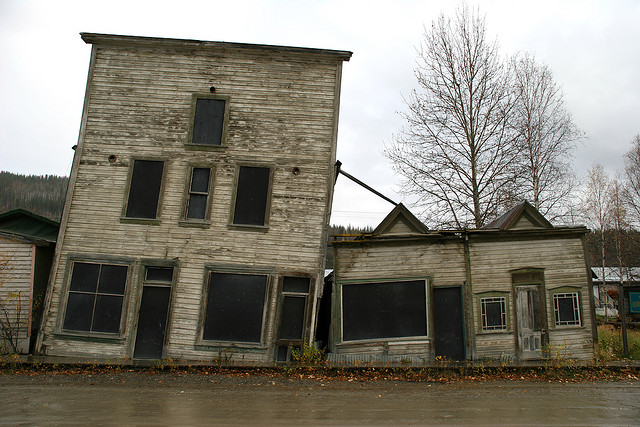
Gold Rush Buildings, Dawson City, Yukon Territory, Canada. © Terry Feuerborn / CC BY NC 2 via flickr
BRONWYN BENKERT is a research project coordinator with the Northern Climate ExChange, Yukon Research Centre, Yukon College, Whitehorse. This article appeared in The Circle 04.15.
In the North, we live on permafrost. Much of our infrastructure is built on ground that is at or below 0°C for two years or more. We travel across permafrost, and it supports our homes and workplaces. Northerners have long had to contend with permafrost in construction and economic development – in the Klondike gold fields, prospectors at the turn of the 20th century actively thawed frozen ground to reach pay dirt, while workers constructing the Alaska Highway during the Second World War battled thawing ground that never stabilized, forcing on-the-fly adaptation of construction processes.
Northerners continue to adapt to our permafrost environment, which forces us to use ingenuity and innovation as we invest in and maintain infrastructure on permafrost. This task has become increasingly challenging, as a result of compounding factors that include heightened development intensity and a changing climate.
The goal of preserving costly northern infrastructure prompts us to develop a thorough understanding of permafrost characteristics and its dynamic responses to anthropogenic and environmental stressors. In Yukon, research focuses on identifying solutions to permafrost thaw impacts on infrastructure. As the only dedicated permafrost research group in northern Canada, the Northern Climate ExChange (NCE), part of the Yukon Research Centre at Yukon College, is working with community, government and industry partners to assess permafrost vulnerability to thaw, and to identify suitable measures to keep it stable.
Yukoners have regularly witnessed impacts of permafrost thaw on infrastructure. In January 2015, a 15-year-old Yukon school was closed due to concerns about its structural integrity. Shifts in the foundation were attributed, at least in part, to permafrost thaw under the building. Substantial investment was required to repair the building before it could be re-opened in September. Prior to the closure of the school, NCE partnered with Yukon government to assess permafrost conditions and recommend practices that could be used to slow or prevent thaw. These ranged from modified snow clearing practices to engineering solutions. Permafrost cores, ground temperature records and geophysics profiles were collected and analyzed by NCE researchers. Together, these approaches form the basis of our understanding of conditions that contributed to infrastructure vulnerability and damage, and may contribute to the preservation and longevity of our buildings.
Increasingly, permafrost-related information is being integrated as part of the planning process for local development. In Yukon, many communities are proactively adopting adaptive planning approaches, based in part on landscape hazard maps the NCE and its partners have developed. These maps integrate current and future hazards associated with permafrost, surficial geology and hydrology into easy-to-interpret, community-scale maps. The hazard risk maps have assisted Yukon communities and other agencies in choosing suitable locations for new infrastructure by helping them avoid key thaw-sensitive areas, and by allowing them to assess the suitability of development projects for local conditions.
In some cases, choosing stable or non-permafrost locations for infrastructure is impractical. Twenty-five percent of Yukon’s 4800 km highway network is built on permafrost. The maintenance of these sections can cost in excess of 5 times that of non-permafrost sections. Where permafrost is already degrading, the management of nearby water and on-going remediation are continually required to reduce infrastructure deterioration. Further, sections of highway overlying permafrost that are currently stable may be affected by future permafrost degradation – it is likely that permafrost impacts on linear infrastructure will become more significant with time.
Fortunately, modified construction practices and thaw mitigation techniques can be used to preserve permafrost and reduce degradation impacts on linear infrastructure like highways.
However, because variability is inherent in permafrost characteristics and distribution, a reasonable solution for one place may be completely ineffective or even damaging at a nearby location. Recently, NCE completed an assessment of permafrost vulnerability to thaw along the northern 200 km of the Alaska Highway, where ice-rich permafrost is located under much of the highway alignment. This characterization has informed the design of solutions that are tailored to local permafrost conditions. Results will guide Yukon government in making strategic investments in the most promising, effective thaw mitigation techniques adapted to local conditions, reducing on-going maintenance costs and preserving highway integrity.
Promoting resilience to permafrost change in the North is a multi-faceted process. It requires basic information regarding the nature, thermal state, and extent of permafrost, as well as ongoing monitoring of permafrost change. Thaw mitigation techniques can also offer protective benefits to infrastructure. Importantly, the development of northern capacity to respond to northern problems like permafrost impacts on infrastructure is helping to ensure improved infrastructure resiliency for our communities.
